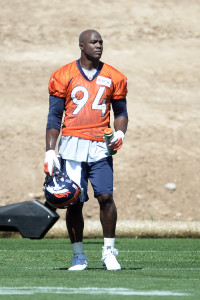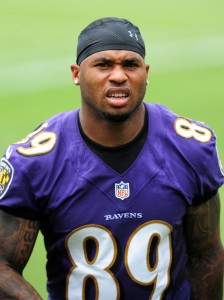Notable signings:
- Austin Howard (OT): Five years, $30MM. $9.9MM guaranteed.
- LaMarr Woodley (DE): Two years, $10.35MM. $4.35MM guaranteed.
- Justin Tuck (DE): Two years, $10MM. $4.35MM guaranteed.
- Donald Penn (OT): Two years, $9.6MM. $4.2MM guaranteed.
- Antonio Smith (DT): Two years, $9MM. $4MM guaranteed.
- James Jones (WR): Three years, $10MM. $3.65MM guaranteed.
- Tarell Brown (CB): One year, $3.5MM. $3.4MM guaranteed.
- Maurice Jones-Drew (RB): Three years, $7.5MM. $1.2MM guaranteed.
- Charles Woodson (S): One year, $3.5MM. $1.15MM guaranteed.
- Carlos Rogers (CB): One year, $3.5MM. $1MM guaranteed.
- Kevin Boothe (G): Two years, $3.425MM. $300K guaranteed.
- Pat Sims (DT): One year, $2MM. $250K guaranteed.
- Usama Young (S): Two years, $2.335MM. $200K guaranteed.
- Khalif Barnes (OT): One year, $1.85MM. $100K guaranteed.
- Darren McFadden (RB): One year, $1.654MM. $100K guaranteed.
- C.J. Wilson (DL): One year, minimum salary benefit. $65K guaranteed.
- Kory Sheets (RB): One year, $525K. $30K guaranteed.
Notable losses:
- Phillip Adams (CB)
- Mike Brisiel (G): Released
- Jacoby Ford (WR)
- Andre Gurode (OL)
- Lamarr Houston (DE)
- Jason Hunter (DE)
- Mike Jenkins (CB)
- Rashad Jennings (RB)
- Jeron Mastrud (TE)
- Daniel Muir (DT)
- Tony Pashos (OT)
- Tracy Porter (CB)
- Jared Veldheer (OT)
- Vance Walker (DT)
Extensions and restructures:
- Taiwan Jones (CB): Extended through 2017. Three years, $4.355MM. $855K guaranteed.
Trades:
- Acquired Matt Schaub from the Raiders in exchange for a sixth-round pick (No. 181). Restructured Schaub’s contract, reducing cap hits for 2014 and 2015. Two years, $13.5MM (2016 year removed). $8MM guaranteed. Can make up remainder of lost ’14 salary in incentives.
- Acquired a seventh-round pick (No. 247) from the Seahawks in exchange for Terrelle Pryor.
- Acquired a third-round pick (No. 81) and a fourth-round pick (No. 116) from the Dolphins in exchange for a third-round pick (No. 67).
Draft picks:
- Khalil Mack, LB, Buffalo (1.5): Signed
- Derek Carr, QB, Fresno State (2.36): Signed
- Gabe Jackson, G, Mississippi State (3.81): Signed
- Justin Ellis, DT, Louisiana Tech (4.107): Signed
- Keith McGill, CB, Utah (4.116): Signed
- Travis Carrie, CB, Ohio (7.219): Signed
- Shelby Harris, DE, Illinois State (7.235): Signed
- Jonathan Dowling, S, Western Kentucky (7.247): Signed
Other:
- Claimed Greg Little off waivers.
- Had agreement with Rodger Saffold fall through due to health concerns.
- Signed 12 rookie free agents after the draft.
- Signed Nnamdi Asomugha to one-day contract so he could retire as a Raider.
The Raiders have been a part of one of the largest rebuilds in recent memory, a full reconstruction from top to bottom. The team has failed to put a competitive product on the field week in and week out since losing to the Buccaneers in Super Bowl XXXVII.
This change is not merely in terms of the roster, but organization wide. Under the control of Al Davis, the Raiders appeared in five Super Bowls. Much of that success needs to be attributed to Davis’ strengths as an owner, a coach, and a general manager. However, under his last decade at the helm, a swarm of bad draft picks, poor trades, and worse contracts crippled the team, leaving them riddled with dead money.
The rebuild started anew in 2012, with former Packers’ executive Reggie McKenzie hired as general manager and former Broncos’ defensive coordinator Dennis Allen hired to be the head coach. The roster began to be stripped down, and the team looked forward to a day when it could become players in free agency once again. That time arrived this offseason.
The Raiders’ offseason has been highlighted to an outsider by the notable losses. Lamarr Houston, Jared Veldheer, Rashad Jennings, and Tracy Porter all left for greener pastures in free agency. The team expressed some interest in keeping them, and was left without viable replacements on the roster. One of the most newsworthy moments of the team’s free agency period was signing Rodger Saffold, which of course fell through due to a failed physical, allowing Saffold to return to the Rams.
With an inability to attract high profile free agents, or even re-sign their own players, many teams would get into bidding wars and be forced to overpay players to add or keep them on the roster. The old Raiders may have participated in this, as they have in years past. This year, however, Oakland allowed free agency to play out. The club signed a large number of reasonable deals, with veterans who had some track record of success.
One-year deals for Tarell Brown, Charles Woodson, Khalif Barnes, Carlos Rogers, Pat Sims, and Darren McFadden gave the Raiders a group of inexpensive but experienced players with something to prove. Other short-term additions included another group of veterans with considerable upside, such as Justin Tuck, Maurice Jones-Drew, Kevin Boothe, LaMarr Woodley, Antonio Smith, Usama Young, and James Jones. Not a single one of these contracts came with more than $4.35MM in guaranteed money, or an average annual salary of over $5MM.
The team’s one major investment was in offensive tackle Austin Howard, who scored a five-year, $30MM contract with just under $10MM in guaranteed money, to shore up their offensive line.
The team will line up newly acquired Matt Schaub under center come September, another veteran with a good track record who only recently fell out of favor with his former club. He cost the team only a sixth-round pick. Compared to some of the quarterbacks the Raiders played over the past half of a decade, Schaub would only need to achieve mild success to be considered a steal. JaMarcus Russell is considered one of the biggest busts in recent draft history. Carson Palmer cost the team a first- and second-round pick. Terrelle Pryor was won in the 2011 supplemental draft for the Raiders’ 2012 third-round pick, and Matt Flynn cost them a fifth-round pick.
The Raiders’ also selected a quarterback in the second round in this year’s draft, taking Derek Carr out of Fresno State. Their first-round pick was used on linebacker Khalil Mack, a selection met with universal praise, as the Buffalo product was viewed as the best player available. Praise is not something the team was used to under Davis. The Raiders were also were able to pick up a fourth-round pick in a draft day trade with the Dolphins, moving down 14 spots in the third round. The move came a year after the Raiders picked up a second-round pick for agreeing to move from the third overall pick down to 12th overall.
These moves may not turn the Raiders into a playoff contender in 2014, as the AFC West was represented in the playoffs by the Broncos, Chargers, and Chiefs. In fact, the Chiefs were one completion from Alex Smith to Dwayne Bowe away from putting all three teams into the second round of the playoffs.
While the division could possibly take a step back, odds are that the Raiders will still end the season in last place. In that case, their coach’s job may be in jeopardy. Although Allen has had limited to work with in terms of roster, reports from earlier this offseason suggested that the team is expecting Allen to start to win with his new players.
Even if the team fails to improve on the field, new philosophies and strategies at an executive level have the Raiders trending in a positive direction. Whether or not the fruits of McKenzie’s labor result in a winning record for the Raiders this season remains to be seen. But for the first time in years, fans in Oakland can clearly see a long-term plan for success being put into practice as the team looks to return to its former glory. They may not have Al Davis sitting in their front office anymore, but it seems the Raiders once again have a commitment to excellence.
Spotrac and Over The Cap were used in the creation of this post.


